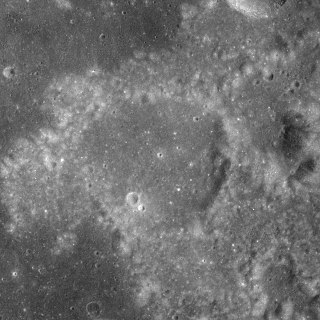 LRO image | |
| Coordinates | 24°42′N152°30′E / 24.7°N 152.5°E Coordinates: 24°42′N152°30′E / 24.7°N 152.5°E |
|---|---|
| Diameter | 78 km |
| Depth | Unknown |
| Colongitude | 209° at sunrise |
| Eponym | Vladimir Komarov |


Komarov is a lunar impact crater that lies across the southeastern edge of Mare Moscoviense, on the northern hemisphere of the far side of the Moon. It is a complex feature with an irregular appearance.

Lunar craters are impact craters on Earth's Moon. The Moon's surface has many craters, almost all of which were formed by impacts.

An impact crater is an approximately circular depression in the surface of a planet, moon, or other solid body in the Solar System or elsewhere, formed by the hypervelocity impact of a smaller body. In contrast to volcanic craters, which result from explosion or internal collapse, impact craters typically have raised rims and floors that are lower in elevation than the surrounding terrain. Impact craters range from small, simple, bowl-shaped depressions to large, complex, multi-ringed impact basins. Meteor Crater is a well-known example of a small impact crater on Earth.

Mare Moscoviense is a lunar mare that sits in the Moscoviense basin. It is one of the very few maria on the far side of the Moon. Like Mare Marginis, this mare appears to be fairly thin. However, it is clearly centered within a large impact basin. It is also much lower than either the outer basin floor or the farside highlands.
The northern rim of Komarov bulges outwards into the mare, giving the crater a pear shape. The regions around the northeastern and southern rims are rugged and uneven, and the crater floor in between has been resurfaced by lava flows that have completely submerged the western third of the interior. This surface is marked by a pattern of multiple rilles that run primarily in a north–south direction, but are cracked like a drying mud bed. Along the interior of the eastern rim is a cleft-like formation that curves along the inner rim. The northwestern rim has an outer rampart where it slopes down to the plain of the neighboring mare.

The lunar maria are large, dark, basaltic plains on Earth's Moon, formed by ancient volcanic eruptions. They were dubbed maria, Latin for "seas", by early astronomers who mistook them for actual seas. They are less reflective than the "highlands" as a result of their iron-rich composition, and hence appear dark to the naked eye. The maria cover about 16% of the lunar surface, mostly on the side visible from Earth. The few maria on the far side are much smaller, residing mostly in very large craters. The traditional nomenclature for the Moon also includes one oceanus (ocean), as well as features with the names lacus (lake), palus (marsh), and sinus (bay). The last three are smaller than maria, but have the same nature and characteristics.

Rille is typically used to describe any of the long, narrow depressions in the surface of the Moon that resemble channels. The Latin term is rima, plural rimae. Typically a rille can be up to several kilometers wide and hundreds of kilometers in length. However, the term has also been used loosely to describe similar structures on a number of planets in the Solar System, including Mars, Venus, and on a number of moons. All bear a structural resemblance to each other.
The crater is named after Soviet cosmonaut Vladimir Komarov (1927–1967).






















